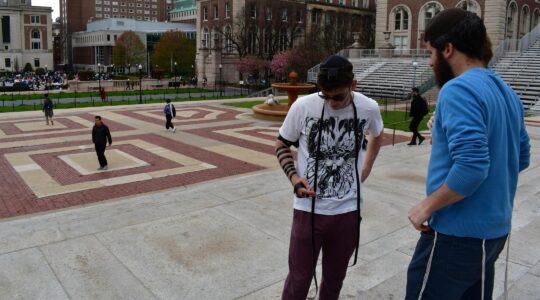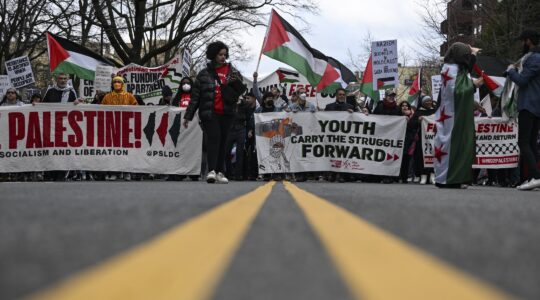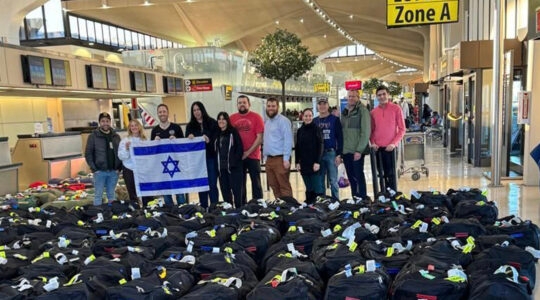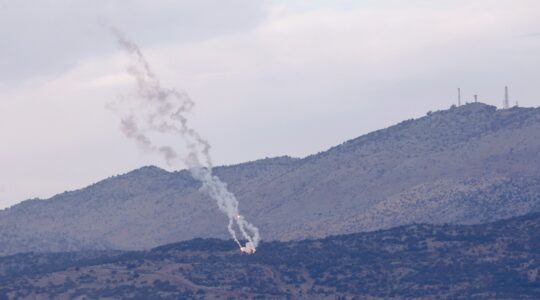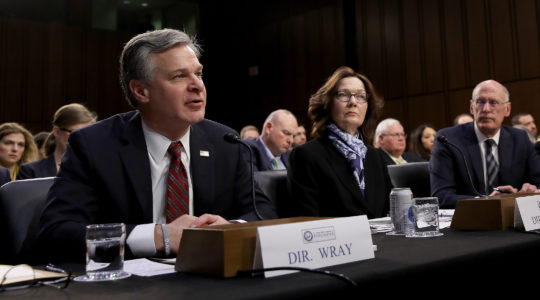SDEROT, Israel (JTA) – For the past several years, Geut Argon has spent little time on the second floor of her home here in southern Israel.
With Palestinian militants in the nearby Gaza Strip regularly aiming Kassam rockets at random targets in this poor, working-class town, it just seemed too dangerous, she says in a recent interview at the Sderot Community Center.
But one afternoon about eight months ago, her son Nir, 4, and his 5-year-old friend Lior begged her to let them go upstairs to see something on the family’s computer. She relented.
Before Argon dropped off Nir and Lior at the computer, Nir headed toward the bathroom. A rocket came crashing through the roof.
“There was just one big boom and then I don’t remember,” she said.
Argon, 35, was knocked unconscious temporarily. She still recalls the horror of the moments after she came to, frantically scrambling through the rubble to find the two children. It wasn’t until she located them, relatively unscathed, that it became clear she was the one who had been wounded.
“Mommy, Mommy. Blood!” Nir screamed.
The gash in Argon’s head would require several surgeries to remove shrapnel embedded in her brain.
Argon is one of the thousands of residents in Sderot and the surrounding towns on the Gaza-Israel border who has received some form of relief from the network of North American Jewish federations and the United Jewish Communities over the past year and a half.
The UJC has doled out some $26 million to its overseas partners, the Jewish Agency for Israel and the American Jewish Joint Distribution Committee, for programs in Sderot. And though it has received some resistance from local federations of late, the UJC hopes to give slightly more than $10 million in additional aid in the coming months.
Argon has received psychological counseling though UJC-funded programming. The Jewish Agency has provided approximately $1,300 through its SOS Fund for short-term relief, but she is waiting to receive money from the Israeli government to fix her house. The Jewish Agency later gave her about $8,000 from its Victims of Terror Fund.
Since April 2001, Palestinian militants have fired an estimated 4,000 rockets and mortar shells at Sderot and the areas near the Gaza border.
The situation has worsened in the past two years, according to Israeli military officials. Nearly 2,900 attacks have come since Israel withdrew from Gaza in August 2005. Some 1,400 have come since Hamas took political control of Gaza in June 2007.
Sixteen Israelis have been killed in the Sderot region since the attacks began.
The Palestinians have increased their firepower, largely with the help of Iran, military specialists say. They have improved the range of their Kassam missiles, started to use 122 mm mortar shells and begun to employ Grad missiles that can reach Ashkelon and perhaps beyond.
As the attacks have increased, the population of Sderot – mostly new immigrants from the former Soviet Union and Arab lands – has dwindled. Although there is no definitive figure on the number of residents that have departed, estimates range from 25 percent to nearly 50 percent in a region that once had a population of 24,000.
Most of those who had the financial means have left, according to municipal officials, social service workers and residents. The majority of those who remain are either idealists or could not afford to leave.
Elsewhere in the world, Israeli and American Jewish philanthropy has focused on removing Jews from endangered areas. But for Israel, the flight from Sderot is troubling – both militarily, as the country’s border could essentially be pushed back, and for national morale, as Israelis see themselves fleeing.
Most of the UJC allocations to the Sderot region have gone to helping the residents endure, giving them respite and offering incentives to others to move to the embattled area. The federation system has allocated some $2.9 million in scholarships for Sapir College in Sderot and more then $5 million to take children in Sderot and Ashkelon out of harm’s way for summer camp.
In sharp contrast to the UJC’s funding strategy up north, where it has directed about $35 million to economic development, less than $1 million of the funds from the federation system has been spent that way in the Sderot area. Lodge said that’s because most of the economic development funding up north was in the form of loan guarantees issued after the conflict with Hezbollah. Such measures, he added, are seen by the UJC as a poor investment during a time of active conflict like the one plaguing Sderot.
The UJC has spent more than $2 million on programs to treat trauma and stress among Sderot residents, as well to promote “resiliency” in coping with the constant threat of rockets. The rate of post-traumatic stress disorder is high among the residents.
The JDC has helped seven of Sderot’s eight elementary schools build “havens of calm,” fortified rooms where students come for alternative therapy sessions in managing their stress. Yoga and pet therapy are among the approaches incorporated into the sessions.
Until recently, aid coming into the region has been slow, especially from the government. Much of the assistance in Sderot from the UJC’s partners thus far has come from the $360 million raised by the North American federations to rebuild Israel’s north in the aftermath of the 2006 war with Hezbollah.
Other than the One Family Fund, which has been helping the people of Sderot since 2004 – it has given more than $1 million in the past year alone – the situation garnered little attention from Israeli society and nonprofits, according to Pini Rabinovich, the coordinator for the organization’s activities in the Jerusalem area and southern Israel.
Sderot’s plight also has been largely ignored by the Israeli public, and the town’s story has been misplayed – and in some cases flat-out missed – by the Israeli media, according to Tal Samuel-Azran, a media specialist at Ben Gurion University.
It’s a turn of events that has frustrated Sderot residents like Argon. Much of the frustration is with the Israeli government, which has provided tax cuts to the region’s residents but has left a void that private organizations such as the UJC have increasingly had to fill.
Argon estimates that the Kassam that hit her house caused $30,000 in damages. The UJC and Jewish Agency assistance was needed because “the government doesn’t want to pay for it.”
“The government? They keep forgetting them, otherwise why do you need so many organizations?” Rabinovich asked at the Sderot center, where the organization’s founder, Mark Belzberg, was distributing books and toys to area children.
When asked about such complaints, the Israeli Consulate in New York noted that the Israeli government has spent about $172 million since 2003 in civilian assistance to residents of Sderot and the western Negev.
“These figures include direct assistance by means of 50% reductions in property tax, 25% reductions of income tax, the highest subsidies for daycare centers, and scholarships for students, among others,” the consulate said in a statement. “The unemployment rate in Sderot is one of the lowest in the country due to government incentives given to investors and entrepreneurs. These figures also includes aid on a regional level by means of upgrading industrial areas; preference for defense ministry contracts; funding communities’ security expenses; aid for agriculture, new immigrants, and large families; investments in neighborhood refurbishment, infrastructure, sewage, roads, and water systems; funding cultural events, increasing school hours, new ambulances, treating psychological trauma, creating new employment opportunities, and many other projects.”
At the same time that residents bemoan what they see as their government’s failures, those on the ground see a new momentum in Sderot-related philanthropy.
“Now it is very popular, it is in,” Rabinovich told JTA.
Argon, for instance, receives aid from four organizations: the UJC, the Jewish Agency, the One Family Fund and another called Chibbuk.
Nachman Shai, the senior vice president of the UJC and director general of UJC Israel, says the Jewish community is starting to recognize the problem in the Sderot region.
At the same time, the UJC has had issues of late raising money for the cause.
The organization largely has been rebuffed in its efforts to raise another $13.6 million from local Jewish federations in North America for helping Sderot, Ashkelon and the surrounding cities, said a UJC official.
The UJC approved an allocation for that amount in March to cover additional Sderot programming, then sent a letter from its leadership to the federations making a soft pitch for money. But the federations have been slow to react, according to Jim Lodge, the UJC’s vice president for Israel and overseas issues.
So far, the federations have given roughly $2.25 million, which the UJC has allocated to five projects. Further projects are on hold until the federations come through with more aid.
“I hope they will respond,” Shai told JTA.
Argon, though, sees hope that the Jewish world is starting to pay attention.
“People know more now I think,” she said. “I don’t think they really knew what was going on until now.”
